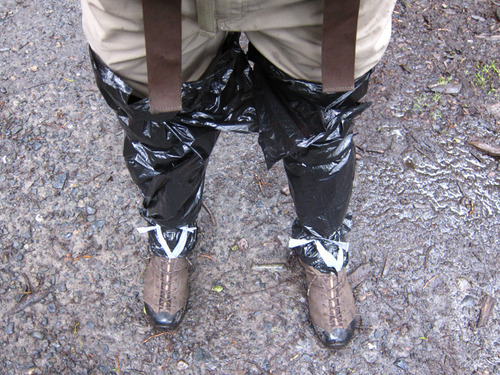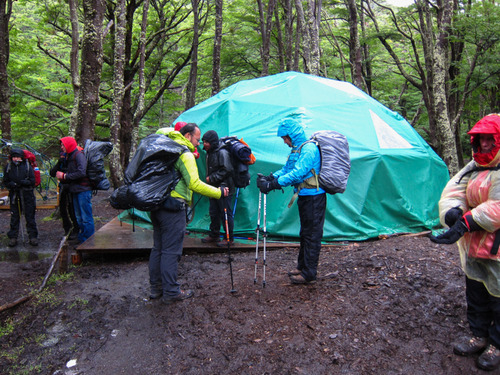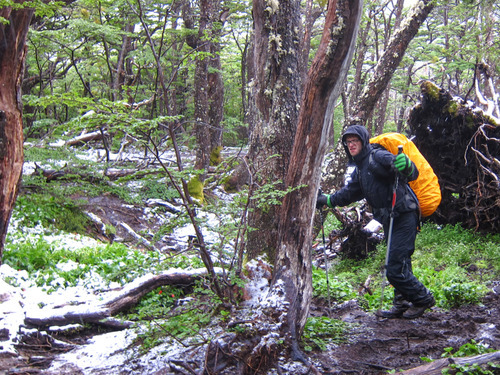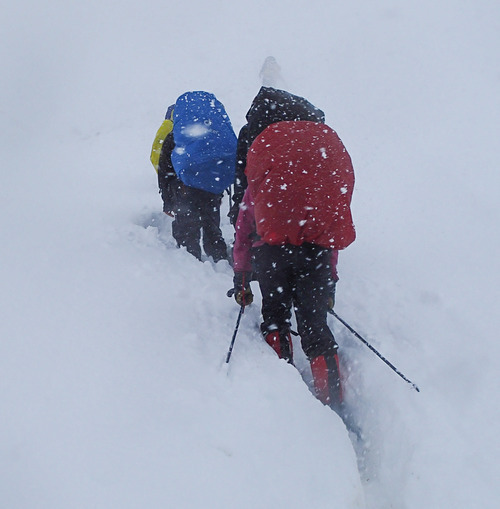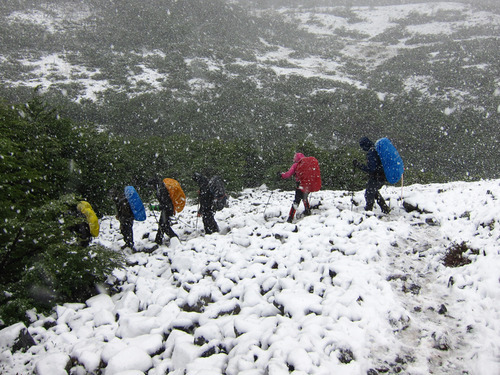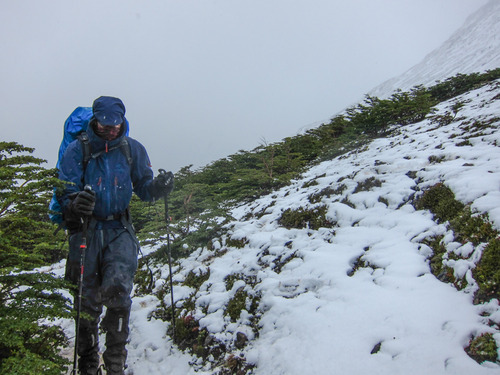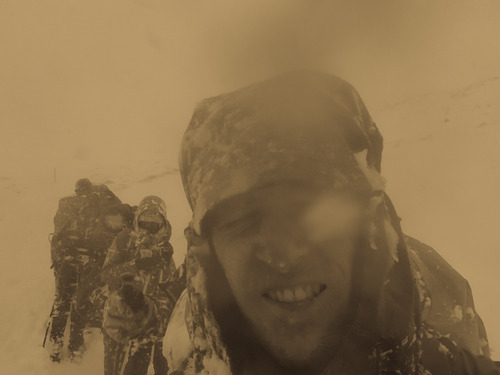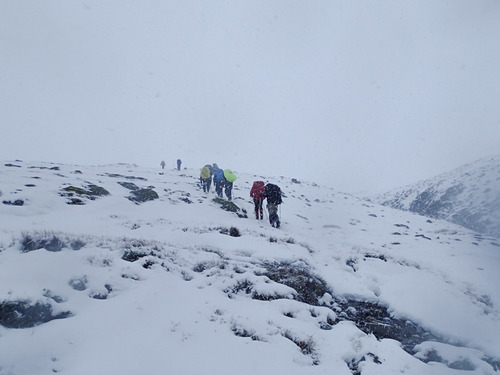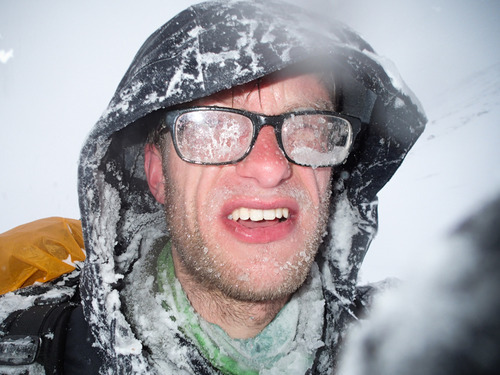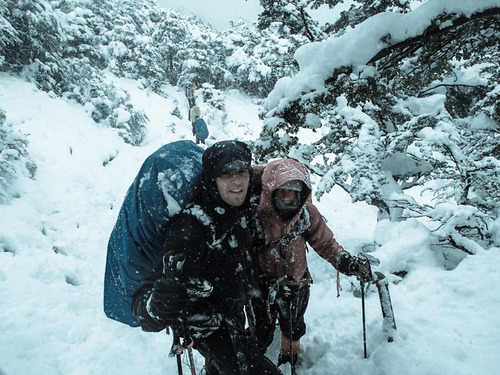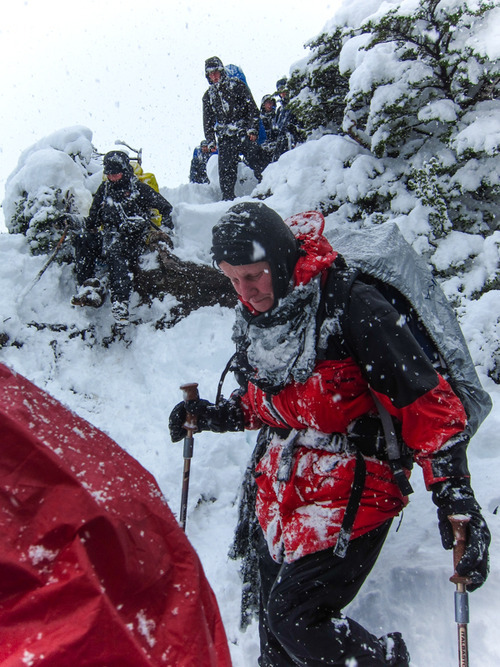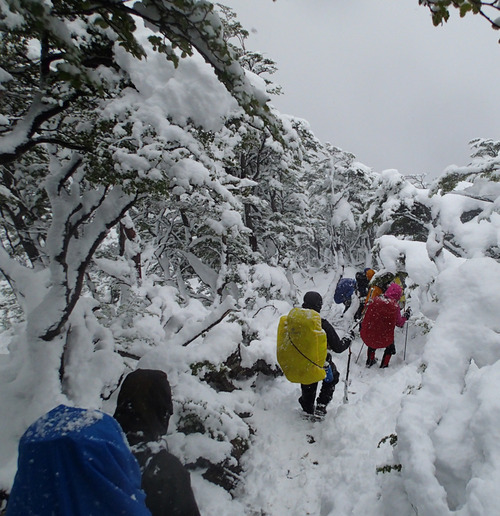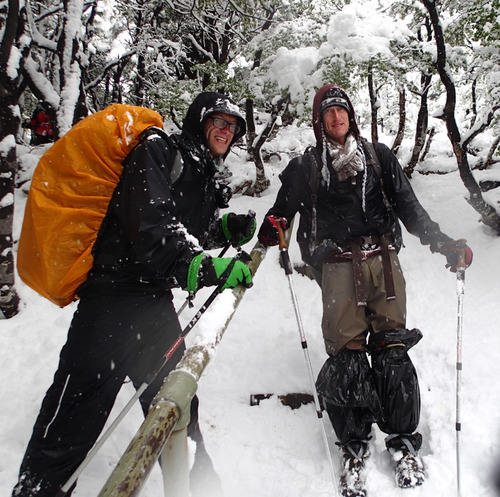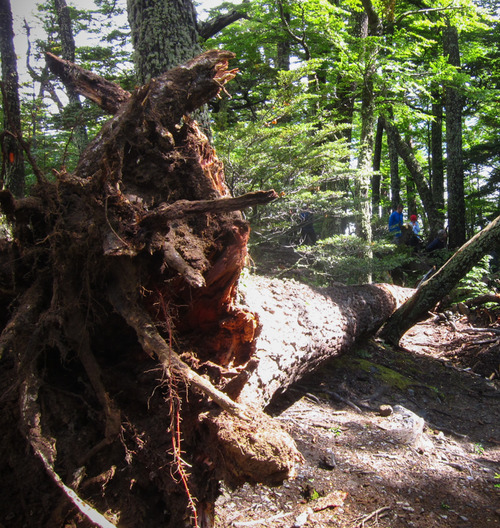12km
“What are the chances of El Paso being open for hiking today?” I said to Simon as we woke in the tent after a night of torrential rain.
“I give it 30%”, I surmised before he could answer. Outside in the campsite, it was snowing. Surely the mountain would be covered in the stuff, at least four feet deep. The three of us lay in our sleeping bags with significant doubts that there would be any trekking that day. The rangers would stop us from leaving and we’d skulk back into our sleeping bags.
The previous evening while we were huddled shivering in the green dome tent, three people had returned to Los Perros camp after unsuccessful attempts at the pass. One German guy had to return after falling and cutting his hand. A French couple hiked for two hours but lost the trail in a whiteout and had to turn back. And that was before the heavy overnight storms.
On the flip side, there were one or two reasons for optimism - the previous evening we’d met a Chilean mountain guide who was attempting El Paso the next day, and there was a rumour that a park ranger would be leading the charge at 7.30am. In theory, all we had to do was fall in behind him.
But, by the time we’d packed and gathered, it emerged that the ranger was not going to materialise, and that the Chilean mountain guide’s team had left early. I guess he didn’t want to take non-paying scragglers like ourselves along for a free ride.
Our team of eight prepared for the hike in the still-falling snow. Rain jackets, backpack covers and gaiters were all standard. I’d like to say we were prepared for the worst, but in retrospect I know that I wasn’t. Strange, because I had pretty accurately guessed how many feet of snow would be on the mountain, yet I still didn’t wear a double layer of pants. Instead I opted for just my quick-dry summer hiking pants, with black garbage bags strapped around my legs to prevent my pants and shoes from being immediately soaked. Instead of wrapping my scarf tightly around my face, I wore a thin cotton bandana. Only one pair of socks. Only myself to blame, really.
We set off just behind another group of about ten hikers. Just out of Los Perros camp the trail began to steepen as it wound through a beautiful snowy forest. It was slow going, as the path was almost completely transformed into a deep mud bath. Hopping from one fallen branch to the next sometimes worked, but occasionally the branch would give way, or a secure looking foothold would turn out to be an icy death slide. There was much cursing as cold feet went into freezing mud, over and over again.
Tom wearing the appropriate expression for the task at hand
After walking for much longer in the forest than we should have, we emerged from the top of the tree line, and there were many oh-my-gods uttered as each person experienced the sting of the howling, antarctic wind without the protection of the trees for the first time. We finally saw the extent of the storm, it’s affect on the visibility and the sheer volume of snow that had fell, and that was still falling. It was only about a foot deep though, and at this point although I thought it was sketchy, I was doubting my initial fears. Perhaps it would max out at around two feet? With the other team of hikers ahead of us cutting the trail, we’d just have to follow in their footsteps. Maybe my socks would even stay mostly dry.
Onward we trekked through the elements, gaining altitude all the time while the snow continued to fall. The wind intensified, howling through us and turning each snowflake into a tiny samurai sword that would slice our eyeballs if we dared open them beyond a squint.
Normally in a snowstorm, I’d be wearing goggles, but I don’t think I’d appreciated just how impossible it was to see without them until that morning in the blizzard. The sting from a single flake in the eye lasts for at least a minute. Pure agony. About the only way to make progress was to look down at the pair of feet in front of me and try take shelter behind the next backpack.
We regrouped around an exposed rock, and noticed that our numbers had increased. Around six new faces had caught up to us, including Americans, Germans and a Chilean couple. We were walking in knee-high snow that seemed to have a nice trail cut through it, at least from where I was in the lineup. At that point, Tom and Simon shouted out to me and asked if I wouldn’t mind moving further up. No problem, I thought to myself, and set off in the front of the pack. I had just one small concern - the trail was missing.
“Where is the path?!” I shouted back to Simon over the howling wind.
“There is none! We’ve been cutting through the snow ourselves” he hollered back. This was the least reassuring thing I’d heard all day. Up until that point, I was convinced we were simply following a well-crafted trail left by the Chilean mountain guide who was in the group only a few clicks ahead of us. Nope. Turned out Tom and Simon were wading through the snow blazing their own path up the pass. And now it was my turn.
Maddeningly, I would squint and catch glimpses of the next group just ahead. But where had they walked? I couldn’t see any evidence of the route they’d taken. The snow must have been falling so hard that their deep tracks were covered before I could use them.
The very same falling snow had also covered the glacial river, which I stepped in and sank knee-deep into, filling my shoe with freezing water. All hope of warmth or dry socks were at that point abandoned. I couldn’t feel my hands, feet or legs, they were all completely numb.
By then, the conditions were too poor to even stop for a break. The only thing keeping the frostbite at bay was constant movement. To even have a drink of water required breaking up the ice that had formed inside the Camelbak tubes. Food that was packed up inside a backpack was completely out of the question. The only thing on our minds was keeping it together, not panicking, putting one foot in front of the other and concentrating on not falling into the snow and disappearing forever.
There were at least some sparsely located orange markers to follow, but with the poor visibility I sometimes couldn’t find the next one. On one of those occasions, we also happened to run into the deepest snow drift yet. The Chilean attempted to push through in one direction but quickly found himself up to his armpits and unable to move. I set off the opposite way, but soon met the same fate and became so entangled that I had to crawl out of the snow on all fours. The rest of the group had gathered, and it was at that moment that I was convinced someone would utter the words I desperately didn’t want to hear: “Let’s go back”. We’d come so far, and I knew it wasn’t long until we reached the top and began the descent, we needed to hang in for just a little bit longer. If we went back, we’d have to retrace our steps for three days, all the way back the the start of the trail, instead of finishing with the glacier.
From out of nowhere, Andy stepped up to save the day. An American guy with a lot of mountaineering experience, he charged straight though the drift like a knife through butter, pushing aside the waist-deep powder with a steady determination. The trail was made. A few meters further over the top of some rocks we spotted the next orange marker. Nobody uttered the words. We were going to make it.
I first heard the yelling and thought something might be wrong. But as I approached the gathering group, I saw what the fuss was about: we’d reached the summit of the pass. Despite the fact that we all knew the steepest terrain lay ahead on the downslope, there was jubilation and hugs all around. It was a mental milestone. There’d be no turning around now.
A minute of celebrating and the Chilean yelled at the group to get a move on. Impossibly, the wind was even stronger on the downslope, approaching gale force. If it weren’t for hiking poles, we’d never have been able to balance. The Chilean hero took the lead and began his half-running, half-falling descent through the powder, the rest of the group following at about the same breakneck pace. We were desperate to get off that rock. There was nothing more important, nothing more urgent. And thankfully, he personally led the charge for the next hour, all the way to the tree line, though some of the most consistently deep snow we’d experienced on the trail. The downhill had advantages: we could move faster. But disadvantages, too: less energy was burned, so it was much colder.
We knew we’d made it when we reached the trees. Sheltered from the wind and snow, we were suddenly engulfed in a surreal calm. There were signs of civilisation, actual steps in the trail and a clear path to follow to the next campsite. The ordeal was over, and after another hour of sliding through the mud, we reached El Paso campsite.
Fiona said I looked like a Shaman descending from the mountains bringing wisdom. I replied, “Sure, and my advice is ‘do not go up there’”
The first thing we noticed was that we were alone. Where had the other group gone to? And why were the rangers at the campsite so surprised to see us and telling us that we couldn’t go any further? Obvious in retrospect, really. Because the pass was closed. Because every other group had turned back, including the Chilean mountain guide’s group. They must have descended a different way, as they never passed by us. The weather had been so bad that radio communication to the Los Perros campsite was impossible. The rangers there weren’t told to stop hikers from attempting El Paso, so they didn’t, although if they’d used a little common sense they could have come to the right conclusion themselves. The whole circuit around Torres del Paine was in fact closed, due to the extreme weather conditions.
Amazingly, the sun came out that afternoon, and we drank hot tea while drying out our equipment. The story was retold and refined, details filled in, terrifying moments shared and thanks to deities uttered. Andy said it was the worst trail he’d followed in all his years of winter mountaineering.
Hours went by before we heard radio reports that the other group had returned safely to Los Perros. But, the word was that they weren’t all there - there were three American girls missing. After comparing notes we decided that they definitely were a part of the big group at some point, and should have been back at Perros. A few radio calls later a search party was formed, tasked with heading back up El Paso to find the missing girls.
Not an hour later the good news came through on the radio from the Dickson camp: the girls had walked past Perros and headed all the way to the more comfortable, less muddy refugio. The search was called off. Everyone was safe. Or so we thought.
At around 5pm, I heard an unmistakable crunching of rotten wood and ripping of branches, as they were torn apart from decades of entanglement. A massive tree was falling, right in the middle of the campsite. I realised the futility of my “watch out” cry as I was speaking the words, so they emerged more as a whimper than a real warning. There was nothing anyone could do, and so we stared in horror as this ancient beast fell with all it’s weight directly onto the Chilean couple’s tent. The tent that they were currently inside, eating their pasta dinner.
The branch that collided with the tent was a sharpened spike, and it punctured through the middle with a clean blow, abruptly stopping and holding the weight of the rest of the tree. It came down perfectly between them. Thirty centimeters difference and one of them would have been dead. Spiked through the heart like a vampire.
The red outline shows where the tent was
But, they emerged unscathed, except for a little knock on the hand. The tent was dismantled around the tree, presumably to be thrown away, and they spent the night in the ranger hut. I guess that’s a fitting way to end the craziest day most of us had ever experienced.

